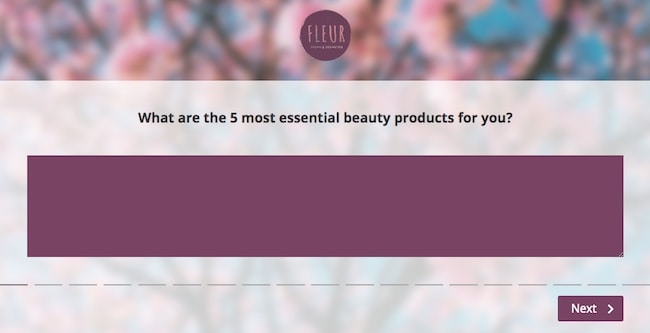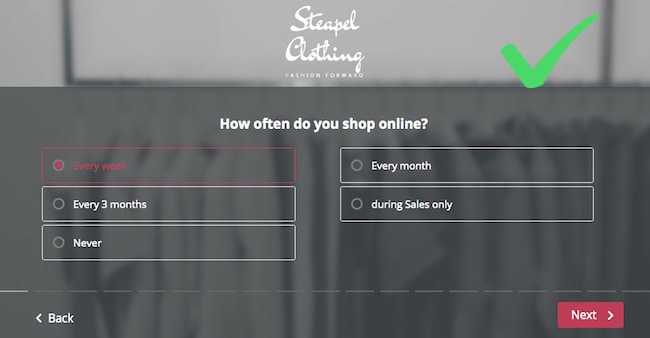Customer surveys primarily include closed-ended questions. It is more difficult to analyse the results of an open-ended question because of its qualitative nature. Yet, asking open-ended questions can prove to be very useful for getting to know your customers better. So, why and how should this type of questions be used? What purpose do open-ended...
Customer surveys primarily include closed-ended questions. It is more difficult to analyse the results of an open-ended question because of its qualitative nature. Yet, asking open-ended questions can prove to be very useful for getting to know your customers better. So, why and how should this type of questions be used?
What purpose do open-ended questions serve in a customer survey?
1 – Open-ended questions are less biased
Open-ended questions allow to collect qualitative answers from customers that are, for the most part, full of information. By asking this type of question, you are giving your customers the opportunity to answer whatever they like, without limiting or influencing them with predefined answers.
Your customers can answer freely. It is not always possible to answer a closed-ended question; sometimes none of the available choices reflect your viewpoint. People don’t always fit in the boxes!

However, don’t be surprised: most of your customers will only spend a few seconds on an open-ended question. This will actually make it easier to interpret their comments though, so it is not a problem.
In terms of customer knowledge, open-ended questions present another advantage. The answers to closed-ended questions are ones chosen by you. But have you thought of everything? You risk finding what you are looking for, but not what your customers actually think.
Asking open-ended questions is a way of opening up to new ideas, to unanticipated answers. These questions are often very instructive.
2 – Open-ended questions are ideal for understanding perceptions
A near-spontaneous answer is particularly useful when evaluating and measuring brand or product awareness, and more broadly, how they are perceived by customers. Take the following example:

3- Improved interactions via surveys
Open-ended questions make customers feel valued. By asking an open-ended question, you are giving a voice to the respondent, thus letting them know that their personal opinion is important and that their answers will not simply be fed into automatically generated statistics.

An open-ended question also allows to break the monotony of a series of these questions. An open-ended question arouses the respondent’s interest, surprises them and dispels their automatic reflexes. In other words, an open-ended question helps make your customer survey more dynamic.
As you can see, there are numerous and undeniable advantages to using open-ended questions.
What difficulties can arise with these questions?
So why, in spite of everything, are open-ended questions often missing from customer surveys, or do they represent such a small minority? A number of disadvantages can be identified if the processing method for these questions has not been sufficiently anticipated. Let’s take a closer look.
Firstly, it is difficult to use answers to these questions in statistics. The answers, qualitative by very definition, do not lend themselves easily to a quantitative analysis. Yet, it can never be said enough – the analysis of customer survey results is a critical step.
If you don’t use verbatim ana
lysis software, you will have to read all the answers manually, and try to sort them by category, for statistical purposes. Which, in all honesty, is particularly time consuming.
But the processing of open-ended question answers is not the only drawback:
- Answers collected from open-ended questions are not always very interesting or useable. Take great care when formulating your questions to avoid leading respondents off-topic.
- Most respondents will simple skip open-ended questions. The response rate for open-ended questions is always far inferior to closed-ended questions. Make sure that your deployment is sufficiently widespread, in order to achieve strong sampling.
- Some respondents are not used to expressing themselves in writing, and their answers are not always very clear, readable or easy to understand. Adding an example to the question can help guide respondents without influencing them.

How to use this kind of questions in surveys?
It is important to be aware of the positive and negative aspects of open-ended questions, in order to successfully incorporate them into your customer surveys.
Open-ended questions allow to find out things you would never have known by only asking closed-ended questions. It is therefore recommended, when necessary, to use open-ended questions.
Use open-ended questions when they bring added value
Don’t overdo this sort of questions. Analysing open-ended question answers is difficult, and time-consuming if you don’thave any tool. We strongly recommend against designing a survey with an equal number of open-ended and closed-ended questions. If you are using text analysis software, we recommend adding an open-ended question every 3 questions. If you plan on analysing the answers yourself, only include one open-ended question for every 5.
It is sometimes possible to acquire sufficiently qualified answers via closed-ended questions. There is no need to ask an open-ended question if you can use a closed-ended one instead. Ask yourself if an open-ended question will add any real value compared to a “closed” answer. Think about it from a customer knowledge perspective.


For smart surveys, open-ended questions can only be deployed under certain conditions. If, in the case of an NPS question, the assigned score is low, an open-ended question will help you understand the reason.
Encourage your respondents to provide concise answers to your open-ended questions
Don’t hesitate to ask your respondents for short answers. You could specify the number of answers for example: “Name 5 smartphone brands”. Or add an adverbial phrase in the question, such as: “in a few words”, “in one sentence”, etc. Short answers are quicker to analyse. They are also often clearer, because they are more direct. Below is an example that perfectly illustrates these last two points.
To find out more, discover our Ultimate guide to creating a customer survey.
Use verbatims analysis tools
This has been mentioned previously in the article. Software of this kind allows to detect the terms most frequently mentioned by respondents, or to identify the negative or positive polarities in the verbatim responses. This allows you to gain a deeper understanding of answers to open-ended questions and to save a lot of time that would otherwise be spent on analysis.

Example of polarity analysis of verbatim with Skeepers
Skeepers CX offers a verbatim analysis module on our Enterprise Feedback Management platform. For an even more detailed analysis, you can also call upon one of our specialist partners such as Proxem, Viavoo or Erdil. Contact us and we will work out the best solution to achieve your objectives together.
In conclusion, here are a few occasions/situations in which open-ended questions are efficient:
– Following a closed-ended question, to complete and expand on an answer
– When the potential choice of answers is so large that asking a closed-ended question would be impossible. For example: What do you do at the weekend?
– When you want to know the words used by your customers, and to discover how they talk about your brand, products etc. These same words can then be reused by customer service.








